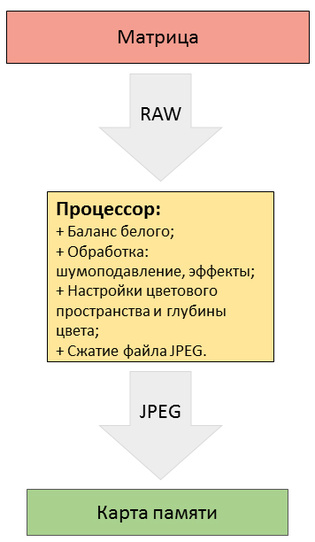Photographic formats
© 2016 website
Fallow in terms of light-sensitive material (swimming or digital matrix) different systems Cameras are divided into three main groups: large, medium and small format cameras. The greater the physical expansion of the photographic material, the greater the detail, the same, and the potential technical clarity of the image, and the greater the bulkiness of the system, the halo. Let's look at these formats in order.
Great format (vin - wide, vіn - great)
Historically great format is the oldest of all photographic formats, it is too early to write off rachunkiv. Perhaps, you will be happy, but old-fashioned bulky large-format cameras are actively sought after by photographers, so as to achieve uncompromising image quality. The cameras of the great format are simply relieved of any kind of automation, and this is why the photographer is the first to start with the traditional photographic medium. As a result, the stench is not very popular among amateurs.
The large-format camera is folded from two walls, closed by a trick, similar to a harmony. On the front wall there is a roztasovuetsya ob'ektiv, povyazaniya іz shutter. The back wall has a frame with a matte fold, which makes it possible to compose the frame and aim the lens at sharpness. A cassette with a sheet of spit is inserted directly in front of the camera.
The walls of the chamber can be shifted between the borders of the expansion of the farm. Changing or making it easier to stand between the walls, the photographer tries to aim at the sharpness. By tilting the walls in parallel planes one to one you can correct the perspective creation, and by swinging or turning the walls one at a time you can change the position of the focusing area, robbing the non-parallel area of the frame.
Absolute control over the perspective of the frame and the depth of the sharply imaged space is the unique power of a large-format camera. So, use special tilt-shift lenses for both small-format and medium-format cameras, but, first of all, the stench does not allow such a large amount of movement, as it is possible in a large-format camera, but in another way, a large-format camera allows you to record audio h be-yakim without blame lens.
In large-format cameras, there is a twist on the look of the green leaves, most often with a size of 4 × 5 inches (significantly closer to 8 × 10 inches). Okremі leaves plіvki, vіdmіnu vіd kotushki, allow іnvidіvіdualі vіdvіvlyat іndivіdіvlyаl іn іdіvіvlyat іn the frame, vіrіyuyuchi іn showing і reactive, sho є dає datkovіl control over brіvієstyu brіvіstyu і contrast of the future znіmka.
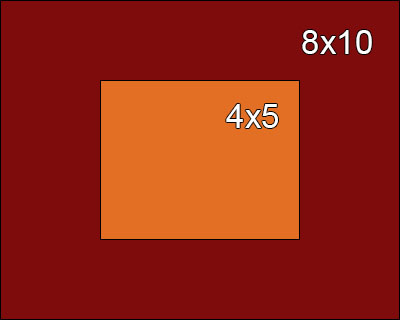
Visual resize frames 8x10 and 4x5
For all the unparalleled advantages of large-format cameras, one cannot help but recognize that the robot is foldable with them and cannot tolerate haste. That's why the stench is more likely to be there today, when there is no time to hurry: at the land of landscapes, at the studio land, and also for scientific and technical purposes.
Today, there are no modern serial digital cameras of the great format. Scanning backdrops (for example, Better Light for example) are less likely to be overwhelmed by the overall indestructibility of the object of capture and the stability of lighting, because skanuvannya stretching the exposition on a lot of quills.
Most of the wide-format photographers take a photo, and then they scan the negatives or slide them on a high-quality scanner. Navit the simplest flatbed scanner with a wide range of 1200 dpi allows you to take a frame size of 4x5 inches. digital image with a retail building 28.8 megapixels. Take the scanner more seriously, and the end of the century will be divided into hundreds of megapixels.
Medium format
Medium format cameras are a compromise between the quality of the image and the clarity of the image. Up to the width of 35-mm cameras, medium-format cameras were valued even more compact (against the large format, mind you), and to that, accessories for reportage, modeling and fishing, tobto. there, de photographer simply does not bother with bulky large-format equipment.
In our days, if small-format cameras (especially digital ones) can see quite decent image clarity, the area of stopping a medium-sized format to finish a picture is, as a rule, a professional studio shot, if 35 mm is small, and tinkering with a large format.
May all medium-format chambers be covered with a type 120 liner. The liner is not perforated, 61.5 mm wide, wound on a spool. Rozmіr kakuru lie vіd specific model cameras. One of the sides of the frame is always 6 cm thick, but the other side can be blown. The most popular square format is 6x6 cm. The least widened size is 6x4.5 (645 format), 6x7 (so-called “ideal format”) 6x9, as well as exotic panoramic formats. One slab of type 120 allows you to work from 8 to 16 exposures. When vikoristannі vdvіchі dovshої plіvki type 220, how to improve the number of cameras, the number of personnel is improved.

Let's look at a frame of large format (4x5), medium format (6x9, 6x7, 6x6 and 645) and small format (35 mm).
Attach medium-format cameras in a different way. The most simple cameras are dual-lens mirror cameras. Offending the lens of such a camera may have the same focal length. One of them is to serve as a light for shooting, and the other one is to form an image on a matte glass screen. For synchronous focusing, a transmission is made that calls the object.
The majority of medium format cameras are single-lens mirror cameras. The light that passes through the lens is reflected by a frail looking mirror uphill, allowing the photographer to compose the frame and focus on sharpness. Before the moment of capture, the mirror is lifted up without interruption, so that the light falls without interruption on the bath. Such a scheme is good for the possibility of image quality in the vidoshukach exactly the way it is easy to rely on the sign, as well as the simplicity of changing the lenses, which does not require modification of the vidoshukach.
To finish the rare far-range medium-format cameras, the video-shower of any of them we will adorn with a clear-cut end at the camera body, and for aiming at the sharpness, serve as an optical far-reaching camera, to show the video-shower. The main advantage of such a design is compact for a medium size camera.
Mayzhe all digital Medium-format cameras range from single-lens reflex cameras. There are also mirrorless devices with an electronic video monitor instead of an optical one. The distribution capacity of medium-format digital cameras is up to 100 megapixels, although the size of the matrix should sound less than 6x4.5 cm.
Being high among the middle of modern digital cameras, the diversity of buildings, digital medium-format cameras are disturbed by significant dimensions and weight, and also by far from optimal ergonomics. The price, as well as the great price, to shatter similar cameras with a tool is only a few powerful professionals, and also a toy for rich amateurs.
Medium format digital SLR cameras are manufactured by Hasselblad, Phase One, Mamiya, Leica, Pentax and Fujifilm.
Small format (vin - narrow, vіn - 35 mm)
Small-format cameras are the most popular due to their compactness and high level of automation. The stench seemed to be indispensable for professional training in sports and wildlife, and even in the amateur medium, most of the time, there is a single zagalovzhivaniye format. Small format is characterized by great variety of cameras, changeable optics and other accessories.
Plivka type 135 maє width 35 mm at a time from perforation. The width of the working area is 24 mm. The frames are expanded horizontally and the size of one frame becomes 36 x 24 mm. 35-mm plait is produced in spools of 36, 24 and 12 frames.
Digital cameras can use a matrix expanded with a traditional 35-mm film frame, tobto. 36 x 24 mm (sound over frame), or smaller size(Crop). Dominant photosensor standards with crop factor ce APS-C (crop factor 1.5-1.6), 4/3" (crop factor 2) and 1" (crop factor 2.7).

Visible to full frame (35 mm), cropped sensors (APS-C, 4/3" and 1"), and sensors of compact digital cameras (1/1.7" and 1/2.3").
Plіvkovі small-format cameras are represented by two main classes: distant cameras and single-lens mirror cameras. The rest were especially popular due to their versatility and efficiency among the animals.
In this hour, the number of 35-mm cameras has become more and more practical. Digital models turn over their slick fronts both for the clarity of the image, and for ergonomics, while at the most affordable price. It is possible to notice a 35-mm glare today either from the day of sentimental mirroring, or in that case, if you break the floor in a deaf place, then recharging the battery of a digital camera becomes, in principle, an impossible problem due to the mechanics of the camera. Vtіm, such vipadki rіdkіsnі.
Far digital cameras are produced exclusively by Leica. The main camcorders for mirror cameras are Canon and Nikon.
There is also a young class of mirrorless digital cameras with an electronic viewfinder, which contributes to the riddle in this division, the shards of the sensory screen with a small-format frame are recognizable to the world, as well as changing lenses. Cameras of this type are practical today for all types of photographic equipment.
less small
Krіm zgadanih vysche three main formatіv іsnuіє kіlka type іv plіvki, so bоvity, arrogant format, recognized ї for vikoristannya in extremely compact cameras. Cі systems (APS, 110, disk plivka, etc.) were prescribed for daily amateur purposes and were not particularly popular in any way. The brightness of the image was in the middle, and the price was clearly dependent. Forget about plіvkovі microformat. The stench has sunk into oblivion, from which I live.
And the axis of digital compact cameras with compact matrices soared and flourished right up to the ubiquitous dominance of smartphones. Regardless of cryogenic receptors, such compacts can be seen to achieve a pleasant brightness, especially with good lighting. Optimal option for a more expensive protocol fee, if the quality of the picture is not a factor in the first row.
Dimensional matrices of compact cameras are arranged diagonally at parts of the sound. Vidicon inch. One Vidicon inch is equal to 2/3 of a standard inch, that is. 16.93 mm. For example, with a diagonal of 1/1.7”, it is ~10 mm, the sensor size is 7.6 x 5.7 mm. The range of expansion sounds to lie at the boundary 1/2.7-2/3”, fallow according to the model.
The remaining fates mark the trend of increasing the size of the matrix in compact digital cameras to the full 35-mm frame for saving the small size of the device itself, which can please.
For respect!
Vasyl O.
post scriptum
As the article appeared for you to be corny and familiar, you can kindly support the project by making a contribution to it. Well, well, the article was not worthy of you, but if you have thoughts about those, how to work it better, your criticism will be accepted with no less dichotomy.
Do not forget that this article is subject to copyright. This quotation is admissible for the presence of a ceremonial citation on the pershogerelo, moreover, the victorious text is not guilty of the same rank, but rather modified.
Image embossing format
Image embossing - Implementation of methods for compressing data to a digital image. Zavdyaki lowering the superficiality of these images, let's improve the efficiency of saving and transmitting images.
The image is squeezed with and without expenses. The methods of embossing without waste are used for archiving images, before stowing any filters (framing, changing the size, correcting the color, etc.), as well as methods with expenses, especially with high embossing factors, to make a difference. The methods with the cost of good are suitable for natural images, such as photographs in supplements, which are small (sometimes incomprehensible) creating images that are generally acceptable to reach a given level of embossing. Stamped from the insides manually vindicated for publication of photographs on the Internet.
JPEG is an embossing format, which somehow reduces the quality, in order to change the size of the file, which is taken by the photograph. Practically all cameras take images in the same format, as you have not indicated otherwise. JPEG images are taken care of by an additional cost compression algorithm, and you can choose the desired compression ratio. The only argument for the cost of greater squeezing is the small size of the files that can be found for manually transferring photographs via email or through the Internet site, as well as the ability to save a large number of signs on the memory card. More cameras allow you to choose two or three equal compressions: normal, kind, and distinguished.
TIFF is a widely accepted image format. Sound, in the TIFF format, cameras take clenched marks, or they follow the algorithm without spending. Tse means high quality, ale, natomist, great expansion of files. Cameras allow you to take photographs in any format, and to print the popular format using the embossing method without waste. The only problem is that many people have changed this format, which is used at the same time 50 or more different formats, and not all are supported by programs.
PNG is an image format, expanded as a replacement for old old formats, expanded in the 1990s. This format is embossed without insertion, like TIFF, but more compact. Hocha, singly, your camera does not support PNG format, a lot of people specially convert photos to this format after transferring them to a computer. On a JPEG view, PNG images do not lose quality after rewriting after modification. digiKam will now support the PNG format, also the module batch processing You can convert an image from any format to PNG in one click. I wondered about the distribution of the Nalashtuvannya, so that I could take the report about the selection of additional modules from digiKam
PNG is a saving format that can be expanded. raster images without spending, good grip. PNG - replacement for the GIF format, which is not patented algorithms, so you can replace it TIFF format. PNG being resized for revisiting the image in the media, in this way, it allows the image to be read in the sequential (streaming) mode. In addition, PNG saves the color and color values for the colored color on different platforms. PNG supports depth of color 8 and 16 bits of color per pixel. This is the ideal format for archiving photos. To find out more about this format, see the PNG homepage.
Deyakі, sing more expensive, photo cameras, proponuyut take photos from the "sire" (RAW) format. There are no suitable singing standards for the orphan format. the stench blows from the virobnik to the virobnik. Syrian format to remove all data, remove without intermediary from the photosensitive element, in front of it, yak software security change the white balance of the camera, or else. Saving photos in the orphaned format, allowing you to slightly change such adjustments, like the white balance, even after the photo is saved on the PC. The majority of professional photographers win the Syrian format, which gives them the maximum flexibility of pre-Drukar training. Zvorotniy bіk gnuchkosti - "siri" photographs occupy an oversized lot of space on the map of memory.
If you want to learn more about the Syrian format, read The Luminous Landscape and Cambridge in Colour. With digiKam you can convert "Syrian" photos to JPEG or TIFF with the help of the "Syrian" image conversion module. Take a look at the Extensions section for how to fine-tune the choice of extension modules in digiKam.
digiKam supports the creation of sketches for "sirih" images of the DCRAW program. Support for the RAW format in the image editor has not yet been implemented. The main RAW formats that are supported by digiKam are reviewed below:
| RAW format | Description |
|---|---|
| CRW, CR2 | Canon camera format |
| MRW | Minolta camera format |
| NEF | Nikon camera format |
| ORF | Olympus camera format |
| RAF | Fuji camera format |
| PEF | Pentax camera format |
| X3F | Sigma camera format |
| DCR, KDC | Kodak camera format |
| SRF | Sony camera format |
| RAW | Panasonic, Casio, Leica camera format |
| DNG | Adobe Format (Digital Negative) |
digiKam has a large number of formats.
The staleness of libraries means that you can't put together an insane list of formats supported by your system. Accept exactly available JPEG, PNG and TIFF
digiKam displays only those files, the formats of which are intelligible. The format depends on the file extension. digiKam displays the file extension with an explicit list. If the list is expanded, digiKam will show the image in the browser instead of the file. You can change the list so that you can recognize it - marvel at the distribution
Modern digital cameras, starting from the models that have been put in, can be used to choose a copy of the file format, in which you can record photos on a memory card. Most often, the JPEG and RAW formats, but sometimes they are added to the TIFF format. In this article, I will tell you about the specifics of these three formats and I will help you choose the format for the capture. In order to understand how the other format of the camera is established, we will briefly look at the main stages of forming an image, exposing the matrix before writing the finished result to the memory card.
Light, touching the matrix, changing the value electric charge element (which will become the pixel of the image). The charge values of the required elements in the matrix are fixed and digitized by an analog-to-digital conversion, and then encoded into a special format, which removes the main name RAW (in English "Syria"). If you choose your own data format, then when a new camera model is released, the programs for processing RAW files cannot open the image, the docks will not be updated when the data about the file format of new cameras is included.
Then the data is collected and processed by the computer. In this case, the white balance is corrected, brightness, contrast, noise reduction, sharpness increase, color depth change up to 8 bits. That's why the camera does everything for us, following one algorithm, without adjusting the individual features of the image. Some of the visual information stored in the RAW format is used for such transformations, but there is no significant increase in brightness, and the squeezing algorithm is broken without losses. For some camera models, it is possible to record an image on a memory card after the processing stage. Tse will be TIFF format.
Further, the information about the image was compiled. When this is done, the algorithm for squeezing out the inserts is used, so that a non-negotiable decrease in the image quality is made. Such a file will take significantly less space, but in the new one it will be only 30-40% of the output information captured by the camera sensor.
Now there is a report about the leather format, yoga and shortcomings
JPEG format.
The widest image format is JPEG (Joint Photographic Experts Group - a group of experts at the gallery of photography, yak developed this coding algorithm). Vin allows you to select images good quality with a small file size.
Format Advantages: small size of the file, a high summity with usma attachments (the image can be looked at on any computer or mobile extension), completely supported by all Internet browsers.
Shortcomings of the format: viklikanі vikoristannyam squeezing algorithm іz vratami. When the file is highly compressed, the file changes, but the quality of the image is significantly reduced, block artifacts of the compression appear.
Image in JPEG format it is not necessary to re-edit and save, shards of skin oversaving - the price of new image embossing with additional expenses. If you need to continue working on images, please use TIFF or PSD format. The number of formats vikoristovuyut algorithms for squeezing data without spending, so the increase in capacity in case of bagatorase oversaving is not required
TIFF format
TIFF (Tagged Image File Format) also the widest image format. Win victorious embossing algorithms without waste, and you can also save data without embossing. Files in TIFF format are usually significantly larger, while JPEG files are smaller. So, as a squeezing, it can be done without expenses, or it doesn’t seem to be necessary, the Danish format ensures a higher quality of the image and often zastosovuєtsya for a more precise preparation of the image to a friend, especially a large format.
Format Advantages: the high quality of the image, the victory of squeezing data without loss
Shortcomings of the format: even more large files, 8-10 times larger, lower image in JPEG format. As a rule, the depth of color is 16 bits, so the file will have more doubles.
RAW format
The file is in RAW format, as we have already said, it is data from the camera matrix, digitized by the processor and "packed" for the help of a special algorithm in the standardization of the camera's compiler, the format and style without any losses, without any processing. In this case, the RAW format takes up significantly less space, lower TIFF, and more, lower JPEG, and 10-16-bit data, depending on the camera model.
All digital cameras use the RAW format, the simplest ones are compact. It's just that not all cameras have this format available for the koristuvach. In quiet situations, if the camera supports the capture in the RAW format, it will be provided with software security, which allows you to carry out an elementary correction in any format and convert it to another, for example, JPEG and TIFF.
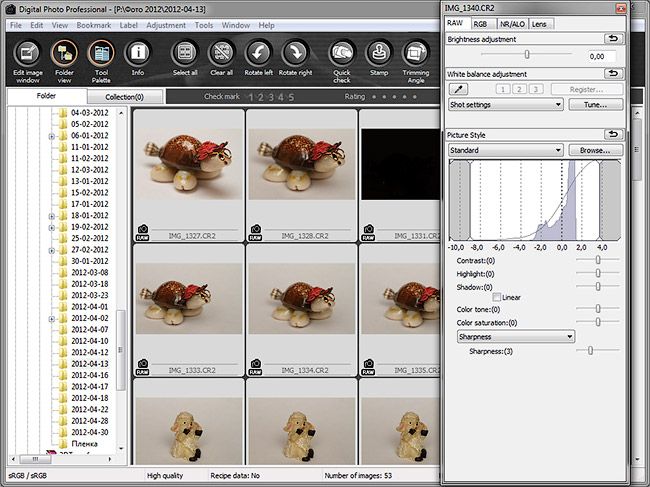
The file in the RAW format is impossible to zip with an unsatisfactory processing - the wines are not edited without interruption and are always left behind by the unmistakable sight. The entire processing is recorded in a small file-instruction, which is written by the program for reading information about the processing and visualization of the image scanned from the RAW-file with the correction of the stale koriguvan. In addition, the RAW format allows you to edit a lot of parameters with minimal loss of brightness, for example, correct the white balance, improve it, add details in bright or dark areas, correct the creation of optics and richly other. In order to better show the advantages of the RAW format, I have recorded a small video clip, in which I show the lightening of the areas of the image.
Advantages of the RAW format: the widest possibility for editing an image with minimal loss of quality, impossibility to zip an output file with a small amount of processing.
Shortcomings of the RAW format: a great deal with the file, you need special programs for reviewing and editing.
In what format do you know?
Choose the image format to fallow depending on the rich factors. A lot of photographers-pochatkivtsiv give a great pardon, knowing only the RAW format, ignoring the JPEG format as flawed. In fact, if the situation permits, it's best to use the RAW format in vipadkah. But in reporting or sports, for example, not using the JPEG format can cause you to miss amazing frames. On the right, the RAW format requires a large buffer memory in the camera, as well as a fast processor. If you take a long series in RAW format, you won’t be able to get the memory card shortcuts - the camera buffer will still be backed up and the camera can’t recognize the dot, the wine docks won’t ring. This hour takes close to ten seconds, enough to miss the last frame. Format JPEG at tsomu vpadku allow not obzhuvat yourself and znіmati skolki zagodno dovgі series of shots. In the minds of the studio or the hour of staging, and also for whatever minds, if you don’t need a serial capture, it’s better to win the RAW format.
The TIFF format for recording victories is not large - it takes up a lot of space on the memory card, and data is recorded less, lower in the RAW format.
Not long ago we had a lesson about the use of modern cameras and their types. There, my trochs bumped into those moldings of a photographic image. Today, we need to develop a report on it, which itself seems to be the result of how light it is to pass through the camera lens, how the camera matrix is powered and what digital photography is ready to be.

The principle of the work of the matrix of a digital camera. What did he say?
The matrix of the camera is a microcircuit, dismantling of millions of light sensitive sensors. The skin sensor registers the brightness of the light that is consumed by it. In such a rank, a mosaic of our image is formed from them. Get respect: the sensor on the matrix registers only the brightness of the light that falls on it, but you can’t take any information about the color. It would have been possible, in such a rank, to take away only monochrome, black-and-white images. For the selection of a color image, there are more complex solutions. In order to obtain information about the color, it is necessary to have at least three light-sensitive elements that are more than one of the basic colors of the spectrum. Therefore, the leather element is equipped with a color light filter, which allows you to change only one color, otherwise.
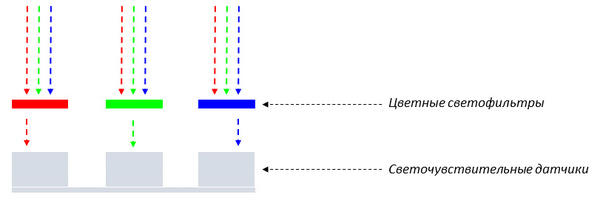
Today in matrices colorful image will come from three basic colors: red, green and blue. Therefore, the matrix of the device is a lattice, which is composed of "green", "red" and "blue" sensors. With different colors, the sensors on the matrix can be different. For example, the widest possible so the titles of the Bayer filter, the names for the name of the yogi winemaker.
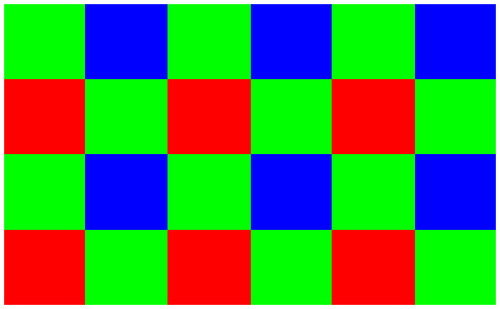
You can remember that there are more green elements on the new one, there are more red ones, or blue ones. It was created in order to compensate for the high sensitivity to the green color of the human eye and to give digital images from the primary people's numbers.
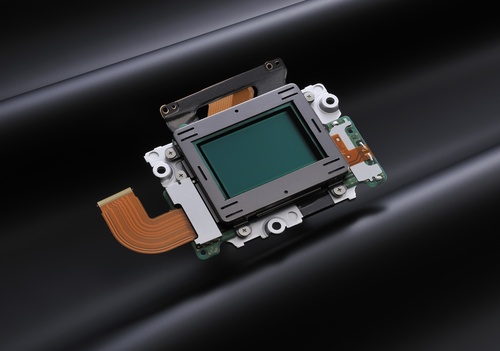
As a result, some data about the brightness and color of the skin sensor, you can add a more colorful image. For which a processor is installed in the camera. We analyze the data that come from the matrices, and put together images from them. Krіm tsgogo, the processor vouches for the inclusion of the images at the outside of the correction, inserted by the photographer, as if he had a balance of white, all the effects of processing. The processor is responsible for the creation of the final file with the photograph.
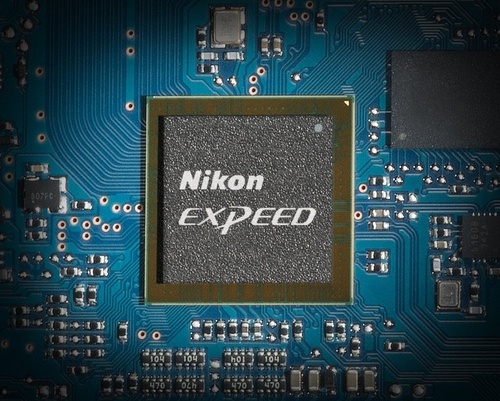
We explained that the matrix of the camera, and the digital image, were created with it in a mosaic, which is made up of small points, pixels. Sounds good, chim Great number the point of mistiming the image, the more detailed, the more detailed, the more visible. How many pixels to replace the image, taken from the camera? This characteristic is called permission. One and the same value - dozvіl, can be expressed in dekіlkom ways. In the case of a different building of the matrix of the camera, simply choose the number of placements per pixel. Oskіlki rahunok pikselіv, raspіshchenih on matrixі, go to milion, їх іх іх іх іміруюют. One million pixels is called a megapixel. If I allow the finished photograph, I often use a different method. Different buildings of digital photography can be characterized by the number of points, horizontally and vertically of the image.

For information, it is important to remember the main things:
The matrix of the camera is made up of light-sensitive elements, the skin of which picks up information about the color and intensity of illumination. Further, these data will be digital images, so the very thing is composed of points - pixels. However, between one light-sensitive element on the matrix and one pixel on the finished image, the sign of equality should not be put: there is a lot to lie in the algorithms of the robot and the matrix and the processor. Do not start the distribution of ready-made znіmkіv dоrіvnyuє number of sensors on the matrix. Deyakі sensors matrices vikoristovuyutsya for vnutrіshnіh, tekhnologichnyh zavdan. Therefore, in the characteristics of the bagatioh cameras, you can use two graphs - the number of effective pixels and just the number of pixels. It is suggested that the created photos will take the fate of effective pixels.
It is important for the mother in the uvazi, that the temple of the building of the matrix is not the only storehouse of the high quality of the bag signs. On the brightness of the final result, there are immaterial factors - and the exposure is correct and the correct focusing is the brightness of the optics. So, in itself, the presence of the matrix high-rise building in the cell allows you to take pictures of high brightness, but it is not guaranteed.
Today, the largest expansion of matrices, prepared for technologies PZZ (CCD) and CMOS (CMOS). Without bothering with theoretical networks, varto is less likely to show that CMOS is a promising technology, chips allow you to achieve greater light sensitivity, reduce digital noise, and change energy efficiency. May all modern cameras today use the same CMOS matrices.
digital noise
What is digital noise? Chantly, everyone noted that sometimes in the photographs there are "overshocks", "grain", other points of a different color. Tse i є digital noise. The amount of digital noise in the photo depends on the characteristics of the matrix of the camera, on the mind and parameters of the camera.
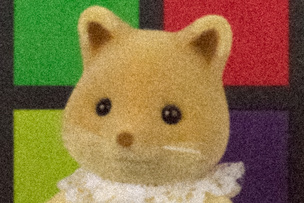

Digital noise is most pronounced when changing to high values of light sensitivity or insufficient lighting. Some other data behind the world are not similar matrices (mostly matrices in smartphones) simply cannot give an image without noise. Also, digital noise may appear during image processing.
RAW and JPEG
In addition, as the zyomka is broken, it is left with no less important tasks - save your photo on the memory card. Bazhano zrobiti tse with maximum capacity, not wasting any information, otrimanoї pіd hour zёmki. Today, more cameras allow you to take pictures from two principal different formats- RAW and JPEG. RAW - tse sire, the information from the matrices is not processed, it is written to the file. Transferring what was given from the file RAW photographer Pratsyuvatime independently, converting yoga on a computer for otrimannya ready photo. JPEG - the photo is actually ready.
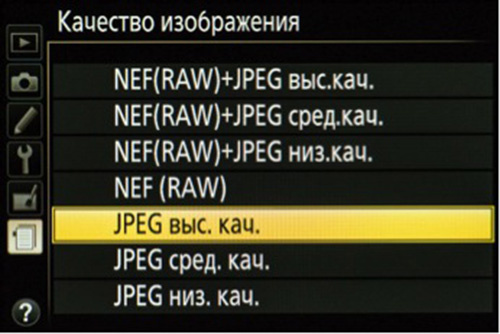
Let's figure out how to get RAW and JPEG files.
|
When changing to JPEG, the camera's processor converts the file to a Syrian signal (essentially the same RAW), superimposing on a new adjustment chosen by the photographer. Adjusting the white balance, carrying out noise dampening (as it was turned on on the camera), stagnant differences in effects (advancing the number of colors, transferring to monochrome only) and adjusting the color. Nareshti, the processor is compressing the file, with the selection of the saving parameters. All the information that was lost as a result of the non-common, visible, is taken away from the bag image. If the file takes up less space on the memory card, the wine will be charged. You can adjust the embossing parameters for JPEG files by selecting the image quality of the camera. In times of strong embarrassment, details may be lost on the print. |

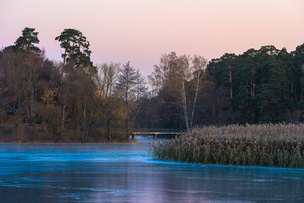
When using Nikon cameras, when processing a possible JPEG-file, the processor can expand the dynamic range of photography for the additional D-Lightning function - it will help to save details in the photo in dark and light villages for an hour of capturing contrasting scenes: landscapes, portraits near the backlight. The same can be done with RAW processing, however, it will require special skills, programs and hours.
|
The English word "raw" is translated by the Russian mine as "Syria", "neobroleny". So out and є. When RAW is taken, the signal that comes from the matrix of the camera is converted by the processor to a file that is attached to be written to the memory card without the usual corrections of the image itself. The file has all the information stored in the matrix. RAW files for cameras of different manufacturers can have different extensions: NEF, CR2, ARW ... However, for the photographer, it does not change. In order to take an image from a “raw” file in RAW format, it will have to be converted on a computer with the help of special programs - RAW converters. With the RAW converter, the photographer can adjust the white balance, correct the exposure of the file, and make a lot of other corrections. |
Among the RAW converters you can see Adobe software Lightroom, Adobe Camera RAW, Capture One. All converters produce special RAW converters for their cameras. For example, Nikon makes two converters. Nikon Capture NX is reimbursed for a casual, professional job, just like the cost-free Nikon View NX for beginner amateur photographers. The main advantage of the RAW format is the naming flexibility of the processing. Adzhe when processing, absolutely all the information is available, it is taken off for the hour of the rent.
Por_vnyannya RAW and JPEG. Yakіst znіmkіv
Vivchimo, as the quality of the image can be taken under the hour of using JPEG and RAW. For the cob, we simply appreciate the quality of the shots taken away from the camera without interruption.
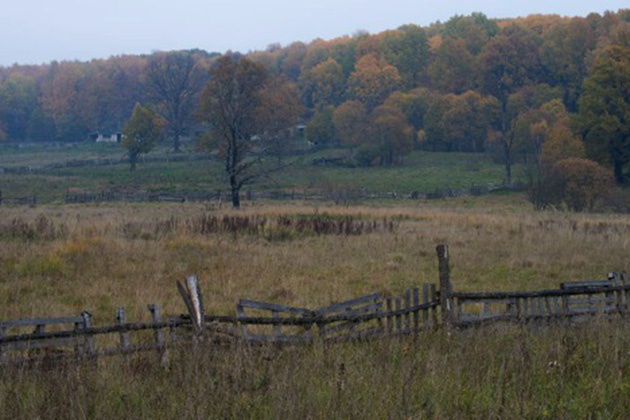
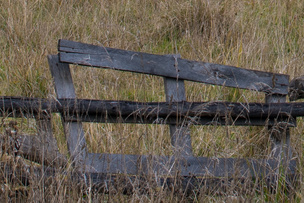
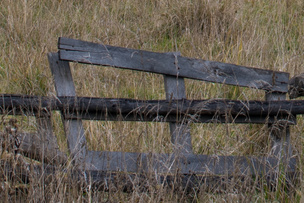
It can be seen jpeg file looking at the trohi rokishim. Due to the processing algorithms, we save the camera. And the axis to reach the sharpness of the RAW image, to reach the processing.
Let's marvel now at the possibility of processing znіmkіv. Let's estimate the possibility of correcting the exposure of frames, broken in JPEG and RAW.

The situation is classic: a sign appears over something dark. Let's try to display frames in JPEG and RAW formats.

It's not a secret for anyone that when changing to high values of light sensitivity, digital noise appears in the photo. All modern cameras have the option of internal noise reduction. The processor processes the image deletion to reduce the amount of digital noise per image. As a rule, in-camera noise reduction systems are faster than noise reduction systems in RAW converters. Aje stinks are “imprisoned” for a specific camera with its own peculiarities. Noise reduction cameras may freeze up to JPEG files.
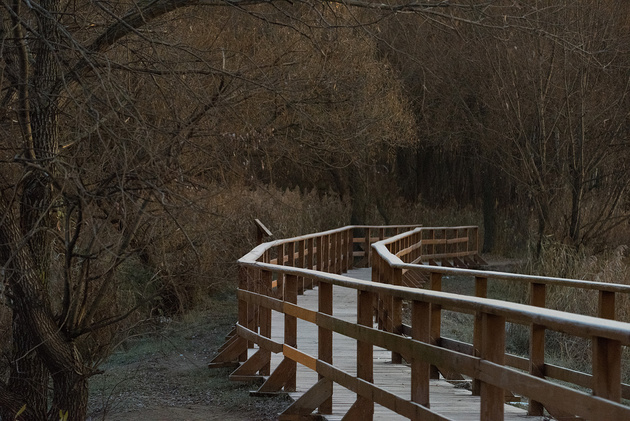
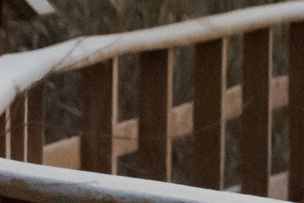
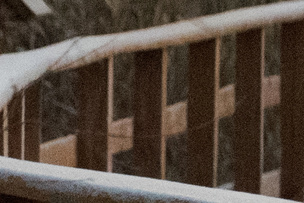
Fragment, converting from RAW without blocking noise reduction.
Digital noise is completely oblivious.
A lot of RAW-converters have options for noise reduction, prote їх efficiency to lie in a specific program and in the type of selected koristuvachny nalashtuvan.
Another classic situation: pardon with white balance. Let's try to fix it for the hour of work from JPEG and RAW.

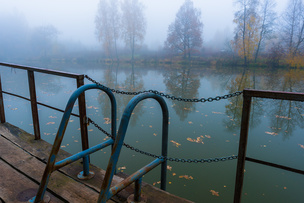
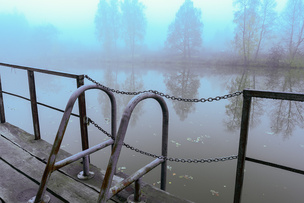
When is the RAW format victorious?
Nasampered todi, if you want to take photographs of high quality, before that, the maximum gnuchki in the form. You will also need at any hour that you can convert files after the acquisition, process them. Most of the time RAW is featured during professional shooting: portrait, landscape, studio.
A lot of amateur photographers-enthusiasts know RAW just to "learn" from a skin photo as much as possible, to practice in the process. But from now on you are engaged in reporting - everything is not so simple. It is possible, while you are converting RAW's with your reportage, taking photos will already lose their relevance. If you try a simple photo for a riddle, RAW is also not the same: photos in any format can’t be thrown off to friends, or publish them in social networks.
When converting to RAW, the photographer may not have to pay attention to the white balance adjustment, even to correct the white balance without any cost, like a picture is possible when converting a computer. So the RAW format itself is more "tolerant" to insignificant exposure flaws - it can be corrected during processing. Perhaps, what exactly cannot be corrected when processing a RAW file is the pardon of focusing and the "thief". Іsnuyu іnstrumenti іnstrumenti kom'yuternogo pіdvishchennya vіzkostі, prote stink not snuff out the problem, not add to the znіmok vіdsutnі details, but less than a trio disguise the problem.
Plus the RAW format:
- allows you to save absolutely all the details, all the information in the photo, take away the hour of rent;
- neymovirna gnuchkіst have obrobtsі. The RAW format allows you to “deceive” a lot of ruined hours of shooting frames, allows you to cheat special computer processing, inconceivable half an hour of shooting in JPEG.
Disadvantages of the RAW format:
- foldability of work with RAW for pochatkivtsiv: to be able to sort out s special programs learn the basics of computer processing;
- for robots with RAW, you need to finish a hard computer;
- work from RAW on a computer for an hour;
- RAW files take up more space on the memory card than JPEG files.
When does the JPEG format win?
Surprisingly, the most popular format among amateur photographers. I don’t want to take the computer to the computer, mother right to do it folding programs- RAW converters. JPEG files immediately after the zomka can be viewed on a matter-of-fact basis electronic attachment, send mail, put it on the Internet. Today, a computer is not needed for anyone, a smartphone or a tablet is sufficient.
Prote, professionals also use JPEG. You add the speed of work, even an hour - pennies. Don't be afraid to take the image the highest quality accessories to processing, but the very security and sturdiness of the work is important. When reporting, for an hour it is important to publish (or correct before the editorial office, agency) photographs right after they go: the better, the better. Let me help a photographer-reporter find a JPEG.
Before speech, before the hour of recording in JPEG, there are many functions of image reduction available, which are available in any modern camera: noise suppression, color enhancement and contrast, dynamic range expansion functions and more. You can make sure that without some kind of computer processing, our photo looks miraculous. With this capture in JPEG, it imposes on the photographer an increase in efficiency: to follow all the parameters, not relying on the possibility of processing. Pardons with a balance of white, blemishes with exposition, after the arrest, correct without serious losses, you can’t go astray.
Advantages of the JPEG format:
- speed of work with files: as soon as the hire is done, we will prepare a photograph;
- rich possibilities of in-camera processing of photos when using JPEG;
- a photograph in JPEG format can be displayed on any electronic device;
- JPEG files can fit a lot less, RAW files can fit a lot more on a JPEG photo memory card.
Disadvantages of the JPEG format:
- less flexibility with computer processing;
- as a reminder of the previous point - for all the parameters, it is necessary to bring more suvoro stezhiti for the hour of the winter.
TIFF format
Some cameras allow one more format - TIFF. Without going into theoretical details, we can say that for a TIFF photographer, it's just like a JPEG. If you want to take pictures without spending any money, but if you don't want to spend an hour on RAW, you can choose TIFF. This format is often favored in printing and design: wine is best in povrivnyanni jpeg clarity the image of that great gnuchkіst during obrobtsі. When saving TIFF, the image is compressed without wasting (like in the case of JPEG). Ale, all the same, when processing the TIFF format, it’s not such a fuzzy yak RAW. Even if RAW is data from matrices, then TIFF is just a picture.

RAW+JPEG
Have not chosen the format yet, do you want to take a photo, recorded RAW and JPEG? There is nothing simple. All modern cameras offer the option of capturing at once in two formats. So it’s all right, as you want to quickly look at the material on any laptop, smartphone, tablet, (even JPEG you can open it on any attachment), select the frames that you were able to, and process the RAW files on a working computer, which is possible practice with them. There is only one obvious minus of this option: there are more files on the memory card, so it will be richer.
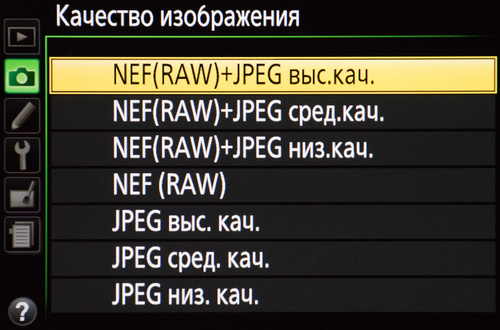
Select “RAW+JPEG” from the Nikon D5300 camera menu. As you can see, you can choose which quality JPEG file to save RAW file. It's handy: you can save space on the memory card for a fee by setting the option "RAW+JPEG low density". For a review, such a photo is useful, and RAW allows the mother to copy the image in maximum brightness.

